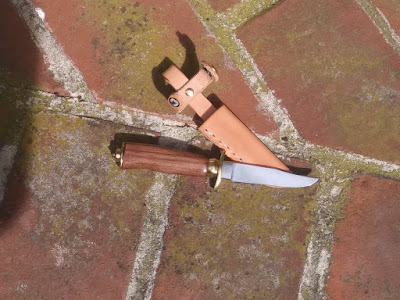This is actually the first hat that I made using the PDF pattern I downloaded from Etsy two years ago, although it's only in the last few weeks that I've reworked it to the point that I find it good enough. Since it's cloth, I needed help from Mom to assemble the top and sides.
The facing fabric is from an old pair of chinos. I used a narrow belt from a thrift store for the chin cord and 4-5 ounce (2mm) veg-tan for the visor. The visor is treated only with neatsfoot oil, conditioner and a little Sno-Seal (emulsified beeswax), which all contribute to darkening the leather to a natural saddle tan color. With no dye, the color shouldn't rub off or bleed, and with no acrylic finish, it won't crack if creased. It's also reasonably water-resistant, though less so than a heavy acrylic finish would be, and of course a glossy finish isn't achievable. If I'd been thinking ahead, I might have made it without vents and used a more old-fashioned slide system for the chin cord, which would make the hat appropriate for the 19th century. As is, I believe the roller buckle is more of a 20th-century feature.
The band is built around heavyweight, 2mm cotton webbing, 1-1/2 inches (38mm) wide. I sewed the crown to the band five warp threads down, though I think it could've been three or even two, which would add a bit of height to the band without weakening the construction. Of course, with a fisherman-style cap like this, you don't really want a tall band; that's more a military peaked cap feature. Speaking of which, the crown could also stand to be about a quarter-inch narrower all around when working with a forgiving fabric, though this doesn't seem to work with leather unless you make the band taller.
After sewing in the visor, I hot-glued a sweatband of cotton twill tape with the idea that it would be replaceable (since the cap itself can't be washed and its light color will show stains from contact with greasy skin), but it took up too much room on the inside. Also, the twill tape had a hard face and was uncomfortable, and proved very difficult to remove. I managed to peel it out and slice off most of the remaining hot glue, and have now replaced it with a chamois leather sweatband in just the front half (where most grease tends to accumulate), attached with rubber cement. It's still a little too snug - I definitely underestimated the hat size during construction - but much more comfortable. The crown has lightweight interfacing and is lined with part of a worn-out cotton bedsheet.
I tweaked the visor pattern several times. I found the supplied version (right) too flat and a bit too proportionally long. At first I thought that widening it would be the best way to get it to curl down more, but in the last few weeks I realized that the major factor is how curved it is on the interior edge: the less curved, the more the visor is turned down when stitched to the straight edge of the band. Theoretically, a completely straight interior edge would result in a visor that points straight down. There actually appear to have been wheel hats made in the 19th century like that, although I don't see the point of such a thing. This cap uses the pattern second to the left, which is perhaps slightly too narrow and not quite full enough on the outer edge near the corners to optimally shield one's eyes from the Sun.






















